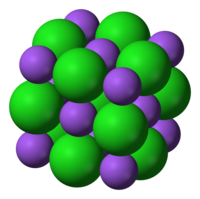锎化合物
锎化合物是锎元素形成的化合物,只有很少一些有所研究。[1]三氯化锎是最先发现的锎化合物,由伯里斯·坎宁安于1960年在劳伦斯伯克利国家实验室制备出来。[2]唯一能在水溶液稳定的离子是三价的锎离子,[3]而二价的具有强还原性,四价的具有强氧化性。[4]锎的氯化物、硝酸盐、硫酸盐和高氯酸盐都是可溶的,而氟化物、氢氧化物和草酸盐是难溶的。[5]
锎的+3价态的代表的三氧化二锎(黄绿色固体)、三氟化锎(亮绿色固体)和三碘化锎(柠檬黄色固体)。[4]其它+3价的还有硫化物和环戊二烯配合物。[6]+4价的典型化合物有二氧化锎(棕褐色固体)和四氟化锎(绿色固体)。+2价的有二溴化锎(黄色固体)和二碘化锎(暗紫色固体)。[4]

简单化合物
编辑二氧化锎(CfO2)是棕褐色固体,属立方晶系,晶体内的晶胞间距为531.0 ± 0.2 pm。[7]三氧化二锎(Cf2O3)通常具有体心立方对称性,加热至1400℃时转变为单斜晶系的晶体,在1750℃熔化。[7]三氧化二锎在高温下可以被金属镧还原为单质锎。[8]
三氯化锎(CfCl3)是翡翠绿色固体,属六方晶系,可以通过Cf2O3和HCl气体于500 °C反应得到。[9] CfCl3可以当作原料来制备橙黄色的三碘化物CfI3,它可以进一步被还原为薰衣草紫色的二碘化物CfI2。[10]三氯化锎直接用氢气还原,可以得到二氯化锎[11],该化合物是稳定的[12]。
三氟化锎(CfF3)是黄绿色固体,其晶体结构在加热至室温之上时逐渐由正交转变为六方。[13]四氟化锎(CfF4)是亮绿色固体,有单斜结构。[14]
二碘化锎(CfI2)是深紫色固体,在室温时有稳定的菱方结构和不稳定的六方结构。三碘化锎(CfI3)是柠檬黄色固体,有菱方结构,在约800℃升华。[15]
氟氧化锎(CfOF)可由三氟化锎在高温下的水解反应制得。[16]氯氧化锎(CfOCl)由三氯化锎的水合物在280–320 °C的水解得到。[17]氯氧化锎是第一个被发现的锎化合物。[18]
硫酸锎在1200 °C的空气中加热,再在500 °C的氢气中还原,可以得到Cf2O3。[9]氢氧化物Cf(OH)3与氟化物CfF3微溶于水。[9]
多硼酸锎是一种较为特殊的化合物,化合物中存在锎和硼酸根的共价键。[19]
氮化锎(CfN)、砷化锎(CfAs)和锑化锎(CfSb)是锎的氮族元素化合物,它们有着氯化钠晶型,可由金属锎和相应的单质化合而成。[20]
配合物
编辑三价的锎离子可以在水溶液中以[Cf(H2O)8]3+和[Cf(H2O)9]3+水配离子的形式存在,成盐[Cf(H2O)9](ClO4)3或[Cf(H2O)9](CF3SO3)3。[21]β-二酮类配合物(如萘甲酰三氟丙酮等)可以和Cf3+形成螯合物,从水溶液中萃取出来。[22]
三氯化锎和过量的2,6-吡啶二甲酸(PDA)于150℃在1:1的乙醇水溶液中反应,可以制得Cf(HDPA)3·H2O[23],它是一种电荷转移配合物。[24]
锎是已知可形成有机金属化合物的金属中,原子序第二大的元素。Cp3Cf(Cp = C5H5)由二茂铍(Cp2Be)和三氯化锎(CfCl3)反应得到,并通过X射线衍射进行了表征。[25]
参见
编辑参考文献
编辑- ^ Krebs, Robert. The History and Use of our Earth's Chemical Elements: A Reference Guide. Westport, Connecticut: Greenwood Publishing Group. 2006: 327–328. ISBN 978-0-313-33438-2.
- ^ Element 98 Prepared. Science News Letters. December 1960, 78 (26).
- ^ CRC 2006,第4-8頁.
- ^ 4.0 4.1 4.2 Jakubke 1994,第166頁.
- ^ Seaborg 2004.
- ^ Cotton 1999,第1163頁.
- ^ 7.0 7.1 Baybarz, R. D.; Haire, R. G.; Fahey, J. A. On the Californium Oxide System. Inorganic and Nuclear Chemistry. 1972, 34 (2): 557–565. doi:10.1016/0022-1902(72)80435-4.
- ^ 朱文祥. 无机化合物制备手册. 化学工业出版社, 2006. pp 171. ISBN 7-5025-8537-0
- ^ 9.0 9.1 9.2 Cunningham 1968,第105頁.
- ^ Cotton, Simon. Lanthanide and Actinide Chemistry. West Sussex, England: John Wiley & Sons. 2006: 168. ISBN 978-0-470-01006-8.
- ^ Peterson J R, Fellows R L, Haire R G, et al. Stabilization of californium (II) in the solid state[J]. Radiochemical and Radioanalytical Letters, 1977, 31(4-5): 277-282.
- ^ Greenwood 1997,第1272頁.
- ^ Stevenson, J. N.; Peterson, J. R. The Trigonal and Orthorhombic Crystal Structures of CfF3 and their Temperature Relationship. Inorganic and Nuclear Chemistry. 1973, 35 (10): 3481–3486. doi:10.1016/0022-1902(73)80356-2.
- ^ Chang, C-T. P.; Haire, R. G.; Nave, S. E. Magnetic Susceptibility of Californium Fluorides. Physical Review B. 1990, 41 (13): 9045–9048. Bibcode:1990PhRvB..41.9045C. doi:10.1103/PhysRevB.41.9045.
- ^ Macintyre, J. E.; Daniel, F. M.; Stirling, V. M. Dictionary of inorganic compounds. London: Chapman and Hall, CRC Press. 1992: 2826. ISBN 978-0-412-30120-9.
- ^ Peterson, J. R.; Burns, John H. Preparation and Crystal Structure of Californium Oxyfluoride, CfOF. Inorganic and Nuclear Chemistry. 1968, 30 (11): 2955–2958. doi:10.1016/0022-1902(68)80155-1.
- ^ Copeland, J. C.; Cunningham, B. B. Crystallography of the Compounds of Californium. II. Crystal Structure and Lattice Parameters of Californium Oxychloride and Californium Sesquioxide. Inorganic and Nuclear Chemistry. 1969, 31 (3): 733–740. doi:10.1016/0022-1902(69)80020-5.
- ^ Seaborg, Glenn T. Man-Made Transuranium Elements. Prentice-Hall. 1963.
- ^ Unusual structure, bonding, and properties may provide a new possibility for a californium borate. 1 June 2015 [29 July 2015]. (原始内容存档于2017-08-02).
- ^ Nave S E, Moore J R, Haire R G, et al. Magnetic susceptibility of CfN, CfAs and CfSb[J]. Journal of the Less Common Metals, 1986, 121: 319-324. DOI: 10.1016/0022-5088(86)90548-5
- ^ Galbis E, Hernández‐Cobos J, den Auwer C, et al. Solving the hydration structure of the heaviest actinide aqua ion known: The californium (III) case[J]. Angewandte Chemie International Edition, 2010, 49(22): 3811-3815. DOI: 10.1002/anie.200906129
- ^ 张青莲 等. 无机化学丛书 第十卷 锕系 锕系后元素. 科学出版社, 1998. pp 322. "12.2.4 锎的水溶液化学"
- ^ Cary S K, Vasiliu M, Baumbach R E, et al. Emergence of californium as the second transitional element in the actinide series[J]. Nature communications, 2015, 6: 6827. DOI: 10.1038/ncomms7827
- ^ Liu G, Cary S K, Albrecht-Schmitt T E. Metastable charge-transfer state of californium (iii) compounds[J]. Physical Chemistry Chemical Physics, 2015, 17(24): 16151-16157. DOI: 10.1039/C5CP01855B
- ^ Laubereau, Peter G.; Burns, John H. Microchemical preparation of tricyclopentadienyl compounds of berkelium, californium, and some lanthanide elements. Inorganic Chemistry. 1970, 9 (5): 1091–1095. doi:10.1021/ic50087a018.
参考书目
编辑- Cotton, F. Albert; Wilkinson, Geoffrey; Murillo, Carlos A.; Bochmann, Manfred. Advanced Inorganic Chemistry 6th. New York City: John Wiley & Sons. 1999. ISBN 0-471-19957-5.
- CRC contributors. David R. Lide , 编. Handbook of Chemistry and Physics 87th. Boca Raton, Florida: CRC Press, Taylor & Francis Group. 2006. ISBN 0-8493-0487-3.
- Cunningham, B. B. Californium. Clifford A. Hampel (编). The Encyclopedia of the Chemical Elements. New York City: Reinhold Book Corporation. 1968. LCCN 68-29938.
- Greenwood, N. N.; Earnshaw, A. Chemistry of the Elements 2nd. Oxford, England: Butterworth-Heinemann. 1997. ISBN 0-7506-3365-4.
- Jakubke, Hans-Dieter; Jeschkeit, Hans (编). Concise Encyclopedia Chemistry. trans. rev. Eagleson, Mary. Berlin: Walter de Gruyter. 1994 [2017-08-02]. ISBN 3-11-011451-8. (原始内容存档于2016-06-03).
- Seaborg, Glenn T. Californium. Geller, Elizabeth (编). Concise Encyclopedia of Chemistry. New York City: McGraw-Hill: 94. 2004. ISBN 0-07-143953-6.